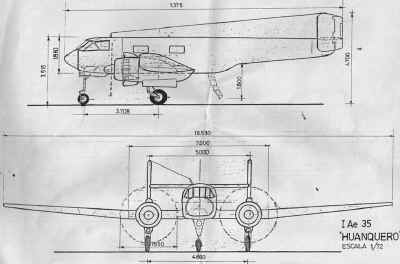Documentation generously donated by:
The IA-35 was a twin-engine multi-role designed by the German engineer Paul Klages and the
professor Kurt Tank; the studies began in 1950 and flew for the first time September 7 of
1953, driven for the 1st lieutenant Jorge Conan Doyle. The airplane was denominated
"Justicialista del Aire."
While they were carried out the first test with the prototype, the Military Factory of
Airplanes, entered in a recessive as for the aeronautical constructions for the general
reorganization in the structure of the same during the year 1954, year in which
nevertheless the second prototype is built.
Already in 1955, the change of politics in the Argentina takes place and several of the
German technicians decide to emigrate. Nevertheless the project IA-35, it not only was
necessary for the requirements of the air force, but rather It also was viable for the
technical and economic possibilities of the FMA. In 1956 grants a new impulse to the
project and March 29 of 1957 leaves from plant the first airplane of the initial series of
four called now "Huanquero." Registered as Ea-001 to the 004, being the 003 a
version of transport, another four would be built in that year.
Although the initial order was to manufacture 100 IA-35, the production stopped in the
number 47. The rhythm of production was the following: 1 airplane in the year 53. 1 in the
54; 8 in the 57; 11 in the 58; 10 in the 59; 8 in the 60; 5 in the 61 and finally 3 in the
62. The Versions that were built where the IA, IB and IV
They were destined to. the II Brigada Aérea in the Base de Reconquista (Santa Fe),
where they lent important services to the II Group of Exploración y Ataque until the year
1974 in which they were replaced for the IA58 Pucará.
Registered as A-300 (trainer of combat), F-300 (Photographic) and T-500 (transport)
from now on.
With wing low cantilever and construction totally metallic, it has the motors with the
landing gear and the pipe of heating in their central housed part, and the external
sectors of the same possess the flaps and the ailerons. The vertical fins had fleetner,
they were worked for cable and they were interchangeable.
The landing gear was tricycle, it housed the main wheels in the baskets of the motors
and they withdrew back with hydraulic mechanisms. The wheel of prow puts up in the fuse
and it equally withdraw back.
The power plant was compound for two IA R-l9A El Indio of 9 cylinders cooled by air, of
650 hp that moved 3-bladed propellers Rotol of variable pass and of constant speed; the
last 28 airplanes were equipped with IA R-l9C of 840 hp
Versions:
IA, advanced Trainer for pilots and navigators, with an instructor and four students.
IB, Trainer of armaments, armed with two Browning machine guns 12.7 Mm in the prow,
another two in a turret worked [hidráulicamente], stations for 4 bombs of 50kg or two of
100kg of bombing, or two rockets of 12.7 [mm] or eight of 5.56 mm.
II, Transport for 7 passengers and 3 crew.
III, Ambulance with 4 stretchers and a male nurse.
IV, Photographic, with Fairchild camera 225 one operator
DIMENSION:
Span 19,60 m
Lenght .13,98 m
High 4,30 m
Wing surface 42 m²
Horizontal fin surface 6 m²
Vertical fin surface 4,40 m²
Maximum height of the canopy 1.86 m
Maximum width of the canopy 1.60 m
